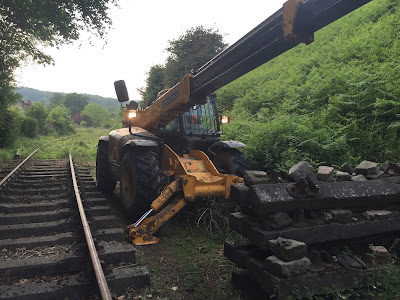Sorry about another delay in writing these,
it’s been a manic few weeks for the Permanent Way Team.
Anybody keen eyed visiting the railway this
weekend will have noticed that the headshunt at Parkend was hurriedly taken out
of use, creating a few interesting shunts. We’ve had a few issues with the
sleepers in place, which were approaching the end of their lifespan. When the
points there were put in, there was a very tight budget, and the sleepers were
simply “plonked” down onto the original ash bed, meaning that they didn’t last
as long as hoped!
Over the last few weeks, we’ve prepared for
the job by lifting the rails of the adjacent siding, and moving them to the
side, by using bars and our trusty Duff-Norton lifting jacks, and digging the
ballast back between the siding’s concrete sleepers.
On Thursday, a team of four of us attempted
to replace the now excavated sleepers by jacking the point up and sliding them
out sideways. This was met with significant problems, with the first sleeper
breaking into four pieces whilst sliding, and required a rethink.
 |
| Multi-part Sleeper! |
Salvation came in the form of a chance encounter between Keith and the Railway’s Development Officer, Jason Shirley, who offered us the use of a Telehandler that we had on hire to unload stone arriving to the railway from our ongoing project at Griffithstown, a chance too good to miss as it would greatly accelerate our progress.
 |
| Telehandler in action just to the north of the headshunt |
A working party was hurriedly assembled on Friday, with Mark and Scott from the Civil Engineering team on hand to drive the telehandler. Unfortunately, the telehandler proved to be the wrong tool for the job, due to its poor maneuverability, as the site was constrained by a large bank on one side and a steep drop on the other, meaning that it was unable to get close enough to the track to be able to lift anything. A new plan was put together, and we decided to go back to the good old manual way, with bars and shovels! By the end of the day, we had the rails lifted out, and all the sleepers removed, some coming out in a few thousand pieces!
Fortunately, Jason came to the
rescue again, and by our next working day on Sunday, we had the Railway’s 360
digger stood on a wagon next to the worksite. This proved to work very well,
and we had the old ballast dug out in a matter of minutes! To counteract the
problems caused to the previous sleepers by sitting directly on the original
ash bed of the railway, and as these sleepers were an inch thinner than the old
ones, we laid down a bed of small stones, to provide drainage from the area,
this again being completed in a matter of minutes!
 |
| The rolling hills of erm.. Parkend. The "Gentle Persuasion" tool in view. |
We then got to work laying out the new
timbers. We chose second hand timbers for this, as hopefully in the next few
years we will be replacing them again, as part as our extension to Traveler’s
Rest and Speech House Road. The timbers were the originals that came out of the
“C” point being installed at the south end of the station, and were still in a
decent condition, and will certainly last the few years that they will be
needed for. Again, the job went extremely well, and we were soon laying the
rails and chairs on top.
By the end of the day, we had all the rails
laid down, ready to be bolted down, and the rails in the siding back in, with
just a bit of fishplating to be done! Roll on Tuesday for the next working day!
 |
| The end of the day, with the sleepers and rails in place. In the foreground are some more sleepers that needs replacing, however less urgently. |
As a bonus, we had several people use the
shunting at Parkend to be passed for several modules in their 08 driver
training! Well done to Rob, Courtney and Huw, who all passed their theory
tests, and Adam, who is now completely qualified, and is already proving to be
valuable, with works trains going here, there and everywhere being planned and
carried out!
 |
| Newly qualified drivers Adam and Courtney go on a ballast run between passenger trains |
No comments:
Post a Comment